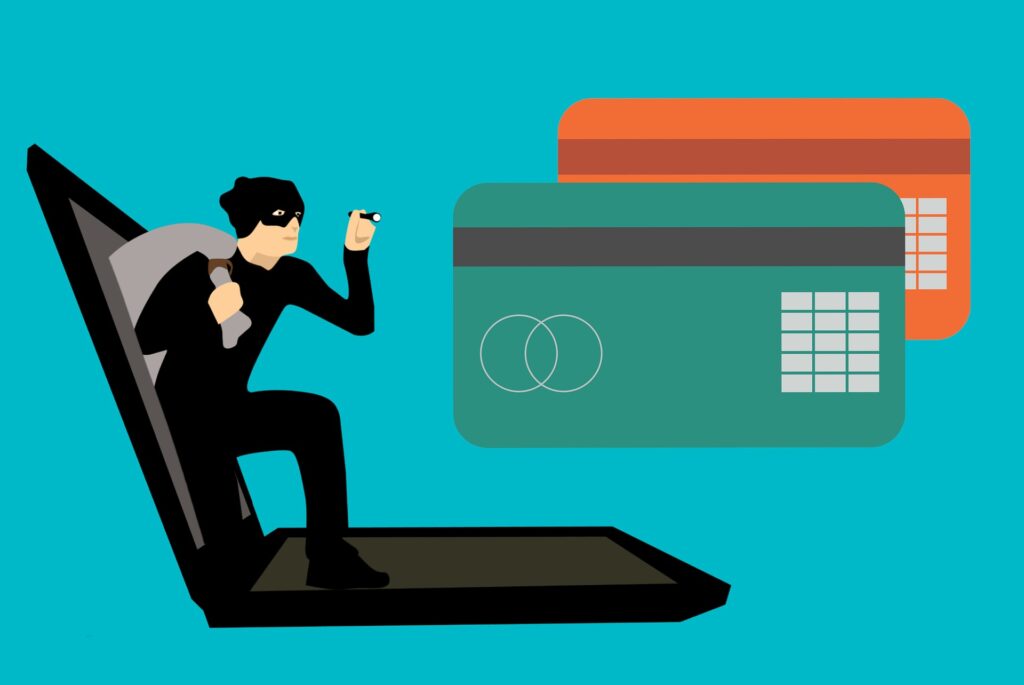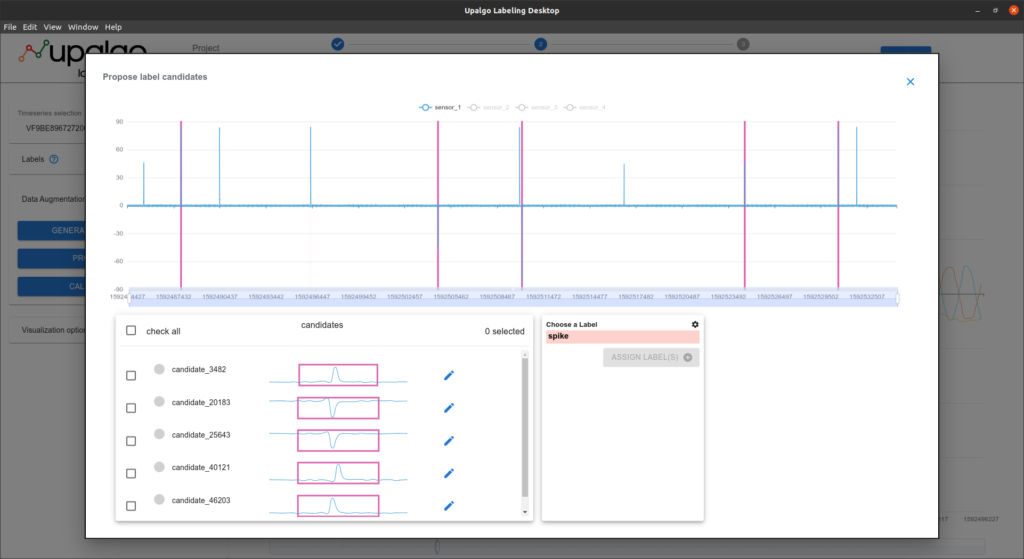Client Use Cases
Advertisement use cases

Fraud detection on digital ads
Problem:
Digital ads are the type of ads you see on websites. They might be in the form of a text, video, image or just a link. Each time a user clicks on an ad or views an ad, the announcer has to pay the publisher a fee.
Fraud in this area is common. In fact, the presence of bots simulating clicks and views have exploded in recent years. This not only distorts the statistics of clicks and visits to the site but also costs a lot of money for virtual visitors that don’t exist.
Solution:
Upalgo Anomaly Detection algorithms will detect the clicks simulated by bots. Upalgo Anomaly Detection will model normal user behaviour through data (IP address, geolocation, mouse movements, time spent on a page, scroll down speed, number of pages on the website, entry page, etc..) and detect abnormal activities.
Benefits:
- money savings
- pay for real users not fake ones
- find unserious marketing partners and agencies
Digital ads are the type of ads you see on websites. They might be in the form of a text, video, image or just a link. Each time a user clicks on an ad or views an ad, the announcer has to pay the publisher a fee.
Fraud in this area is common. In fact, the presence of bots simulating clicks and views have exploded in recent years. This not only distorts the statistics of clicks and visits to the site but also costs a lot of money for virtual visitors that don’t exist.
Solution:
Upalgo Anomaly Detection algorithms will detect the clicks simulated by bots. Upalgo Anomaly Detection will model normal user behaviour through data (IP address, geolocation, mouse movements, time spent on a page, scroll down speed, number of pages on the website, entry page, etc..) and detect abnormal activities.
Benefits:
- money savings
- pay for real users not fake ones
- find unserious marketing partners and agencies

Anomaly detection on marketing performances
Problem:
To be efficient and competitive, marketers must run effective advertising campaigns that are well-integrated to their target markets. Up and downs should be monitored to react effectively. However, with the increasing number of marketing channels and verticals, it can be very hard for a team of marketers to monitor everything efficiently.
Solution :
Upalgo can help marketing teams to automatically alert on unseen marketing dips and rises. Upalgo learns a company’s typical behaviour to alert teams of suspicious and radical changes in data. The teams can then take action sooner than later while focusing their effort on high ROI tasks in the meanwhile.
The data analysis can be based on data coming from pay-per-click, website traffic and customer behaviour.
Benefits :
- better ROI
- operate things more easily and efficiently.
- better client satisfaction
- optimization of the campaigns ( discovering new opportunities)
- understand marketing trends.
To be efficient and competitive, marketers must run effective advertising campaigns that are well-integrated to their target markets. Up and downs should be monitored to react effectively. However, with the increasing number of marketing channels and verticals, it can be very hard for a team of marketers to monitor everything efficiently.
Solution :
Upalgo can help marketing teams to automatically alert on unseen marketing dips and rises. Upalgo learns a company’s typical behaviour to alert teams of suspicious and radical changes in data. The teams can then take action sooner than later while focusing their effort on high ROI tasks in the meanwhile.
The data analysis can be based on data coming from pay-per-click, website traffic and customer behaviour.
Benefits :
- better ROI
- operate things more easily and efficiently.
- better client satisfaction
- optimization of the campaigns ( discovering new opportunities)
- understand marketing trends.
Aerospace use cases

Satellite Health Monitoring
Problem:
Satellites are very important to human needs from communication to space comprehension, and they need to be maintained well. Anomalies can have serious consequences and lead to expensive repairs or the loss of the entire satellite.
Solution:
Satellites are full of sensors of any kind to make the controller’s command work properly. If something goes wrong, they will send the information to the controller’s command. In this context, satellites need a health monitoring system capable of detecting anomalies.
Upalgo Anomaly Detection will analyze all the data collected from the satellite's sensors and pinpoint anomalies. Thanks to its Machine Learning algorithms, Upalgo Anomaly Detection can identify where to look and where the anomalies will arise.
Benefits:
- save time
- save money
- real-time detection
- productivity
- reduce satellite failure
- reliability
Satellites are very important to human needs from communication to space comprehension, and they need to be maintained well. Anomalies can have serious consequences and lead to expensive repairs or the loss of the entire satellite.
Solution:
Satellites are full of sensors of any kind to make the controller’s command work properly. If something goes wrong, they will send the information to the controller’s command. In this context, satellites need a health monitoring system capable of detecting anomalies.
Upalgo Anomaly Detection will analyze all the data collected from the satellite's sensors and pinpoint anomalies. Thanks to its Machine Learning algorithms, Upalgo Anomaly Detection can identify where to look and where the anomalies will arise.
Benefits:
- save time
- save money
- real-time detection
- productivity
- reduce satellite failure
- reliability

Glitch detection during engine testing
Problem:
During the testing of new engine prototypes, tens and hundreds of sensors send data through the network for collection and storage. Some of these sensors are high-frequency (50 kHz) wireless sensors. Sometimes they can get desynchronized or disconnected. Due to this, the collected data can contain glitches. These glitches in data can lead to errors in the phases of post-treatment operations.
Solution:
Upalgo Anomaly Detection can detect in real-time, glitches, with Deep Learning algorithms. Upalgo can also correct automatically these data errors, thus creating a better data set of high quality.
This use case has given the opportunity to Ezako and its client Safran to publish a research paper on the subject, which was presented at the Bindt 2021. The paper called DETECTION OF ANOMALIES ON SIGNALS DURING AIRCRAFT ENGINE TESTS can be downloaded through this link: https://ezako.com/en/deep-learning-signal-anomaly-detection-paper
Benefits:
- data quality for further analysis
- save time
- increase in productivity
During the testing of new engine prototypes, tens and hundreds of sensors send data through the network for collection and storage. Some of these sensors are high-frequency (50 kHz) wireless sensors. Sometimes they can get desynchronized or disconnected. Due to this, the collected data can contain glitches. These glitches in data can lead to errors in the phases of post-treatment operations.
Solution:
Upalgo Anomaly Detection can detect in real-time, glitches, with Deep Learning algorithms. Upalgo can also correct automatically these data errors, thus creating a better data set of high quality.
This use case has given the opportunity to Ezako and its client Safran to publish a research paper on the subject, which was presented at the Bindt 2021. The paper called DETECTION OF ANOMALIES ON SIGNALS DURING AIRCRAFT ENGINE TESTS can be downloaded through this link: https://ezako.com/en/deep-learning-signal-anomaly-detection-paper
Benefits:
- data quality for further analysis
- save time
- increase in productivity
Agriculture use cases

Cow monitoring
Problem:
Cow herds require a lot of care and time. Farmers need to make sure the cows are healthy. They also would like to know the right time for breeding to be more productive. Such work can be time-consuming and expensive. If the farmer does not detect injuries or the poor health of a cow, it can have serious consequences.
Solution:
With a connected collar mounted around the neck of the cows, a 3-axis accelerometer collects data. This data is analyzed by Upalgo Anomaly Detection and Pattern Recognition algorithms. We can then detect if a cow is injured. The anomalies detected can be sent as an alert to the farmer, who in return will act on the health issues or organize the future breeding phases.
Benefits:
- minimize the amount of work done by the farmer to check one by one every animal in the herd
- save money (the average price of a cow is 1500 euros. if a cow isn’t properly treated, it can lead to her death so to loss of money)
- improve productivity
- improve the cow welfare
Cow herds require a lot of care and time. Farmers need to make sure the cows are healthy. They also would like to know the right time for breeding to be more productive. Such work can be time-consuming and expensive. If the farmer does not detect injuries or the poor health of a cow, it can have serious consequences.
Solution:
With a connected collar mounted around the neck of the cows, a 3-axis accelerometer collects data. This data is analyzed by Upalgo Anomaly Detection and Pattern Recognition algorithms. We can then detect if a cow is injured. The anomalies detected can be sent as an alert to the farmer, who in return will act on the health issues or organize the future breeding phases.
Benefits:
- minimize the amount of work done by the farmer to check one by one every animal in the herd
- save money (the average price of a cow is 1500 euros. if a cow isn’t properly treated, it can lead to her death so to loss of money)
- improve productivity
- improve the cow welfare

Anomaly detection on smart hydroponics farms
Problem :
Smart hydroponics farms are great for growing food in a scalable and controllable way. The complex automation enables high yields by using data collected from sensors. However, unexpected situations can result in a quality decrease.
Solution :
After the data collection process with the relevant features (e.g. temperature, ph, humidity, CO2 levels, location, et cetera), Upalgo Anomaly Detection can train the best algorithms and detect anomalies within time series data.
Benefits:
- diminish risk
- improve productivity
Smart hydroponics farms are great for growing food in a scalable and controllable way. The complex automation enables high yields by using data collected from sensors. However, unexpected situations can result in a quality decrease.
Solution :
After the data collection process with the relevant features (e.g. temperature, ph, humidity, CO2 levels, location, et cetera), Upalgo Anomaly Detection can train the best algorithms and detect anomalies within time series data.
Benefits:
- diminish risk
- improve productivity
Automotive use cases

Health monitoring of cars
Problem:
Production and test processes can be prone to failures, which reduces productivity and significantly increases miscellaneous costs.
Solution:
Fortunately, one can have recourse to Machine Learning models in order to handle this problem properly. An expert can proceed as follows: collect some data and feed Upalgo algorithms with them. The output of this process will be the identification of abnormal samples. In terms of applications, this may help to prevent and predict valve fouling for example.
Benefits:
- improve productivity
- lower cost
- gain customer trust and satisfaction
- addresses security concerns
- prevent and predict future failure
Production and test processes can be prone to failures, which reduces productivity and significantly increases miscellaneous costs.
Solution:
Fortunately, one can have recourse to Machine Learning models in order to handle this problem properly. An expert can proceed as follows: collect some data and feed Upalgo algorithms with them. The output of this process will be the identification of abnormal samples. In terms of applications, this may help to prevent and predict valve fouling for example.
Benefits:
- improve productivity
- lower cost
- gain customer trust and satisfaction
- addresses security concerns
- prevent and predict future failure

Charging station anomalies for electric cars
Problem:
Electric cars are more and more popular with users, especially with the price of gasoline which continues to rise. However, electric cars come with some infrastructure challenges: too many unexpected outages during the charging process, cable problems, unable to start a charging process… All these obstacles have to be overcome before mass adoption.
Solution :
Upalgo can come in handy to solve these issues. By finding predictively the different anomalies, technical maintenance teams can intervene quickly and avoid unexpected breakdowns.
Benefits :
- predictive maintenance;
- fewer breakdown;
- money saver;
- user satisfaction.
Electric cars are more and more popular with users, especially with the price of gasoline which continues to rise. However, electric cars come with some infrastructure challenges: too many unexpected outages during the charging process, cable problems, unable to start a charging process… All these obstacles have to be overcome before mass adoption.
Solution :
Upalgo can come in handy to solve these issues. By finding predictively the different anomalies, technical maintenance teams can intervene quickly and avoid unexpected breakdowns.
Benefits :
- predictive maintenance;
- fewer breakdown;
- money saver;
- user satisfaction.

Driver behaviour recognition
Problem:
In the future our cars will be able to understand the context in which the driver and the passengers are. This is crucial for the comfort and safety of the users. For example, by understanding that the driver is falling asleep, a car can be able to take back control or stop the car in a safe way.
Solution:
Anomaly detection systems and Pattern Recognition algorithms can detect, and predict diver behaviour. By collecting data from sensors in the cockpit (acceleration, breaking, seat weight sensors, steering wheel, etc…) Upalgo can detect the life situation of the driver.
Benefits:
- gain customer trust and satisfaction;
- addresses security concerns;
- improve their image.
In the future our cars will be able to understand the context in which the driver and the passengers are. This is crucial for the comfort and safety of the users. For example, by understanding that the driver is falling asleep, a car can be able to take back control or stop the car in a safe way.
Solution:
Anomaly detection systems and Pattern Recognition algorithms can detect, and predict diver behaviour. By collecting data from sensors in the cockpit (acceleration, breaking, seat weight sensors, steering wheel, etc…) Upalgo can detect the life situation of the driver.
Benefits:
- gain customer trust and satisfaction;
- addresses security concerns;
- improve their image.
Banking use cases

Fraud detection in banking
Problem:
Institutions and businesses face massive losses due to fraud. According to Crowe UK, fraud has cost the global economy $5.38 trillion in 2021. Fraud can have consequences on banks and their customers. Indeed, more and more transactions are done online due to the emergence of e-commerce and fraudsters can take advantage of and scam buyers.
For example, a fraud can be electronic fraud, or pishing. Electronic fraud consists of illegally accessing and using another person's personal data on the Internet; and pishing consists of obtaining another person's data via email and pretending to be that person and using their data in an illegal way (transfer, purchase...).
Banks and other companies have to find a good solution that will allow them to reduce costs and improve customer trust and satisfaction. The solution has to be able to prevent and detect those frauds.
Solution:
Fraud detection through Machine learning and artificial intelligence is highly recommended for its efficiency in terms of quality, speed, and cost. However, this strategy requires some prerequisites, the most important one being the data collection process. Given the nature of the problem, an expert may choose to collect data samples with features allowing to discriminate well between fraudulent transactions and normal ones (e.g. location, mail, amount of items purchased).
Besides the data collection process, the choice of the model is also critical. In general, practitioners favour supervised models since there is empirical evidence according to which they perform better than the unsupervised ones on several problems. The added value of the Ezako platform, named Upalgo Anomaly Detection, is to revert this paradigm by proposing highly-efficient unsupervised approaches to deal with anomaly detection. The output of the proposed models will obviously be a binary variable: fraudulent or non-fraudulent transaction.
Benefits :
Thanks to an Anomaly Detection solution, companies :
- gain the customer trust and satisfaction;
- keep and improve the image of their company;
- detect, prevent and eliminate fraud;
- detect in real-time;
- are more efficient with faster fraud detection;
- lower their cost.
Institutions and businesses face massive losses due to fraud. According to Crowe UK, fraud has cost the global economy $5.38 trillion in 2021. Fraud can have consequences on banks and their customers. Indeed, more and more transactions are done online due to the emergence of e-commerce and fraudsters can take advantage of and scam buyers.
For example, a fraud can be electronic fraud, or pishing. Electronic fraud consists of illegally accessing and using another person's personal data on the Internet; and pishing consists of obtaining another person's data via email and pretending to be that person and using their data in an illegal way (transfer, purchase...).
Banks and other companies have to find a good solution that will allow them to reduce costs and improve customer trust and satisfaction. The solution has to be able to prevent and detect those frauds.
Solution:
Fraud detection through Machine learning and artificial intelligence is highly recommended for its efficiency in terms of quality, speed, and cost. However, this strategy requires some prerequisites, the most important one being the data collection process. Given the nature of the problem, an expert may choose to collect data samples with features allowing to discriminate well between fraudulent transactions and normal ones (e.g. location, mail, amount of items purchased).
Besides the data collection process, the choice of the model is also critical. In general, practitioners favour supervised models since there is empirical evidence according to which they perform better than the unsupervised ones on several problems. The added value of the Ezako platform, named Upalgo Anomaly Detection, is to revert this paradigm by proposing highly-efficient unsupervised approaches to deal with anomaly detection. The output of the proposed models will obviously be a binary variable: fraudulent or non-fraudulent transaction.
Benefits :
Thanks to an Anomaly Detection solution, companies :
- gain the customer trust and satisfaction;
- keep and improve the image of their company;
- detect, prevent and eliminate fraud;
- detect in real-time;
- are more efficient with faster fraud detection;
- lower their cost.

Mortgage Prepayment Anomalies
Problem :
Anomalies in the mortgage industry are explained by a high velocity of change. This makes it more and more impossible for companies to predict profitable models and prepayments. Change can happen at any time and have consequences such as :
- insecurity
- high risk
- delinquency
- default of payment
Solution :
By assuming that the data collection process has been achieved, an expert can, via Upalgo Anomaly Detection, set up a carefully tuned machine learning model and apply it to detect market change and therefore, identify anomalies. Thus, it is possible to make better prepayment and profitability models, reducing the mortgage credit risks.
Benefit :
Thanks to an Anomaly Detection solution, companies gain in :
- scalability;
- accuracy;
- profitability.
Anomalies in the mortgage industry are explained by a high velocity of change. This makes it more and more impossible for companies to predict profitable models and prepayments. Change can happen at any time and have consequences such as :
- insecurity
- high risk
- delinquency
- default of payment
Solution :
By assuming that the data collection process has been achieved, an expert can, via Upalgo Anomaly Detection, set up a carefully tuned machine learning model and apply it to detect market change and therefore, identify anomalies. Thus, it is possible to make better prepayment and profitability models, reducing the mortgage credit risks.
Benefit :
Thanks to an Anomaly Detection solution, companies gain in :
- scalability;
- accuracy;
- profitability.
Cyber security use cases

Intrusion detection
Problem:
“A cyberattack is a malicious and deliberate attempt by an individual or organization to breach the information system of another individual or organization.” The cost of cybercrime amounted to 600 billion dollars in 2021 (Cybersecurity Ventures).
Cyberattacks can be manifested in different forms as phishing, malware, and Man-in-the-Middle (attack through unprotected WiFi for example). These painful and malicious activities are spreading proportionally to the growing importance of digital technologies in our modern lifestyle.
Solution:
Machine learning in cybersecurity is used to detect and respond to attacks efficiently. In order to do this, Upalgo Anomaly Detection collects data and detects patterns of shady activities. This software will analyze data through carefully fine-tuned Machine/Deep Learning algorithms, leading to the detection of potential cyberattacks and also zero day attacks.
Benefits:
- Prevent threats;
- Respond to active attacks;
- Improve security process.
“A cyberattack is a malicious and deliberate attempt by an individual or organization to breach the information system of another individual or organization.” The cost of cybercrime amounted to 600 billion dollars in 2021 (Cybersecurity Ventures).
Cyberattacks can be manifested in different forms as phishing, malware, and Man-in-the-Middle (attack through unprotected WiFi for example). These painful and malicious activities are spreading proportionally to the growing importance of digital technologies in our modern lifestyle.
Solution:
Machine learning in cybersecurity is used to detect and respond to attacks efficiently. In order to do this, Upalgo Anomaly Detection collects data and detects patterns of shady activities. This software will analyze data through carefully fine-tuned Machine/Deep Learning algorithms, leading to the detection of potential cyberattacks and also zero day attacks.
Benefits:
- Prevent threats;
- Respond to active attacks;
- Improve security process.
Defense use cases

Trajectory anomalies
Problem:
Understanding what are the factors that influence the trajectory of a missile is key for mission success. Hitting the target with the maximum accuracy is the ultimate goal. To attain this goal companies try different scenarios and parameters in their simulations. How to predict errors, problems, trajectory
Solution:
Upalgo detects automatically the anomalies in missile firing tests and trajectories. It classifies the type of error and finds clusters to regroup them.
Benefits:
- better reliability;
- better security;
Understanding what are the factors that influence the trajectory of a missile is key for mission success. Hitting the target with the maximum accuracy is the ultimate goal. To attain this goal companies try different scenarios and parameters in their simulations. How to predict errors, problems, trajectory
Solution:
Upalgo detects automatically the anomalies in missile firing tests and trajectories. It classifies the type of error and finds clusters to regroup them.
Benefits:
- better reliability;
- better security;
Energy use cases

Rotating machine anomalies
Problem:
Hydroelectric generators are used to produce electricity. They produce electricity from a flow of moving water. These contain rotating parts that can fail. For example, in order to function properly, there must be a minimum water flow. If not moving parts can get damaged very fast. When a hydroelectric generator breaks, there is a double effect on costs. First, the repair can cost a lot of money with parts to be ordered and teams to be made available. Second, there is a production deficit, as it can’t produce electricity. Moreover, this downtime can lead to the shutdown of the units that depend on this hydroelectric turbine.
Solution:
The generators equipped with sensors will help the utility companies create the right algorithms: vibrations, pressure, temperature, flow etc.. Upalgo Anomaly Detection will use these data to train predictive algorithms and detect in advance any disparities indicating a future outage. Using Upalgo helps avoid unplanned failures, thus saving millions of dollars each year in repairs, component replacement, downtime and lost revenue.
Benefits:
- money saver;
- resources saver;
- time saver.
Hydroelectric generators are used to produce electricity. They produce electricity from a flow of moving water. These contain rotating parts that can fail. For example, in order to function properly, there must be a minimum water flow. If not moving parts can get damaged very fast. When a hydroelectric generator breaks, there is a double effect on costs. First, the repair can cost a lot of money with parts to be ordered and teams to be made available. Second, there is a production deficit, as it can’t produce electricity. Moreover, this downtime can lead to the shutdown of the units that depend on this hydroelectric turbine.
Solution:
The generators equipped with sensors will help the utility companies create the right algorithms: vibrations, pressure, temperature, flow etc.. Upalgo Anomaly Detection will use these data to train predictive algorithms and detect in advance any disparities indicating a future outage. Using Upalgo helps avoid unplanned failures, thus saving millions of dollars each year in repairs, component replacement, downtime and lost revenue.
Benefits:
- money saver;
- resources saver;
- time saver.

Predictive maintenance on wind turbines
Problem:
Wind turbines are highly utilized and their number continues to grow. Given their costs, they need proper maintenance. Considering that these devices can be prone to failures for which the repair processes can be difficult, manufacturers have to:
- maintain the good health of wind turbines;
- predict and reduce failures;
- improve productivity;
- be efficient.
Solution:
Upalgo can detect anomalies in real time. With anomaly detection and machine learning, we are able to identify variables or elements that don’t belong to an expected pattern in the same data set and that can’t be seen by humans. Delivering such a result requires to follow a process:
collecting data from sensors;
recognising the patterns within the time-series data graph;
detecting anomalies.
Benefits :
- reduce failures;
- save time;
- lower costs.
Wind turbines are highly utilized and their number continues to grow. Given their costs, they need proper maintenance. Considering that these devices can be prone to failures for which the repair processes can be difficult, manufacturers have to:
- maintain the good health of wind turbines;
- predict and reduce failures;
- improve productivity;
- be efficient.
Solution:
Upalgo can detect anomalies in real time. With anomaly detection and machine learning, we are able to identify variables or elements that don’t belong to an expected pattern in the same data set and that can’t be seen by humans. Delivering such a result requires to follow a process:
collecting data from sensors;
recognising the patterns within the time-series data graph;
detecting anomalies.
Benefits :
- reduce failures;
- save time;
- lower costs.
Healthcare use cases

Pulse monitoring
Problem:
Pulse monitoring is done today by analysing rule-based thresholds that are inefficient to reveal certain anomalies.
Solution:
Automatic anomaly detection systems can leverage much more through this type of data and help diagnose certain diseases and hearth abnormalities.
Benefits:
- detect irregularities and diseases
- improve the quality of treatment
- reduce medical costs
Pulse monitoring is done today by analysing rule-based thresholds that are inefficient to reveal certain anomalies.
Solution:
Automatic anomaly detection systems can leverage much more through this type of data and help diagnose certain diseases and hearth abnormalities.
Benefits:
- detect irregularities and diseases
- improve the quality of treatment
- reduce medical costs
IoT use cases

Life situation pattern detection
Problem:
Nowadays, the Internet of Things is ubiquitous. Many industries transition to a more digitalized world by connecting to the internet their devices: manufacturing, healthcare, tobacco, automotive, and retail… The data collected is enormous but leveraging value out of it remains a hard task. Teams can’t scale fast enough to treat all the data.
Solution:
Upalgo Anomaly Detection and Pattern Recognition offers a perfect solution to this issue. Upalgo has a low code interface which makes it perfect to scale the Big Data analysis. Companies can treat more data and leverage their understating of operations and clients.
Benefits:
- easier data analysis
- scalability
- cost efficiency
Nowadays, the Internet of Things is ubiquitous. Many industries transition to a more digitalized world by connecting to the internet their devices: manufacturing, healthcare, tobacco, automotive, and retail… The data collected is enormous but leveraging value out of it remains a hard task. Teams can’t scale fast enough to treat all the data.
Solution:
Upalgo Anomaly Detection and Pattern Recognition offers a perfect solution to this issue. Upalgo has a low code interface which makes it perfect to scale the Big Data analysis. Companies can treat more data and leverage their understating of operations and clients.
Benefits:
- easier data analysis
- scalability
- cost efficiency
Manufacturing use cases

Product quality surveillance in Manufacturing
Problem:
Industries must reduce production costs, analyze risks and avoid losing money. The production process is sometimes very long and can be quite expensive. Hence, it is in the interest of the manufacturer to stop the production line as soon as possible in the case of a problem, which requires having the right tools at your disposal.
Solution:
One of the best tools to address this problem while reducing cost and improving quality is Upalgo Anomaly Detection. This predictive tool will analyze the whole production line, then thanks to its Deep Learning algorithms, will go through the dataset patterns and detect abnormalities. An abnormality is an unexpected change from an expected pattern. By knowing the normal process, Upalgo Anomaly Detection will be able to warn when there is an anomaly.
Benefits:
Thanks to an Anomaly Detection solution, gains are:
reduced defective products;
lowered equipment downtime;
optimized energy consumption;
optimized operations;
money savings.
Industries must reduce production costs, analyze risks and avoid losing money. The production process is sometimes very long and can be quite expensive. Hence, it is in the interest of the manufacturer to stop the production line as soon as possible in the case of a problem, which requires having the right tools at your disposal.
Solution:
One of the best tools to address this problem while reducing cost and improving quality is Upalgo Anomaly Detection. This predictive tool will analyze the whole production line, then thanks to its Deep Learning algorithms, will go through the dataset patterns and detect abnormalities. An abnormality is an unexpected change from an expected pattern. By knowing the normal process, Upalgo Anomaly Detection will be able to warn when there is an anomaly.
Benefits:
Thanks to an Anomaly Detection solution, gains are:
reduced defective products;
lowered equipment downtime;
optimized energy consumption;
optimized operations;
money savings.

Predictive maintenance in the Manufacturing Industry
Problem:
The maintenance of machines can be a hard task to do by professionals. A machine can run to failure and it can lead to lower productivity and financial losses.
Manufacturers who do not use predictive maintenance use planned maintenance. To be able to do planned maintenance operations, machines must have known, relatively stable and predictable failure frequencies. The problem here is that it is very difficult to predict accurately without computer assistance.
Manufactures have to:
predict future failures;
make choice between keeping a machine who have remaining functional life (with a risk of failure) or replacing it;
to improve their machinery;
maintain their productivity.
Solution:
IoT (Internet of Things) especially sensors provide data that can be used to detect anomalies. Sensors can capture the temperature, sound, and vibration …
AI based predictive maintenance can detect anomalies in real time. With anomaly detection, one can identify automatically the samples that deviate from the data distribution. These anomalies are symptomes of future outages our inneficiencies.
There are 4 steps :
collecting data from sensors;
within the time-series data graph, recognize the pattern;
detect anomalies
label the anomalies for future identifications.
Benefits:
Thanks to anomaly detection, manufactories gain a lot of benefits :
preventing unplanned failure;
reducing planned failure;
increasing the productivity;
lowering the cost;
better use of maintenance resources;
improving machinery health and performance;
reducing defects.
The maintenance of machines can be a hard task to do by professionals. A machine can run to failure and it can lead to lower productivity and financial losses.
Manufacturers who do not use predictive maintenance use planned maintenance. To be able to do planned maintenance operations, machines must have known, relatively stable and predictable failure frequencies. The problem here is that it is very difficult to predict accurately without computer assistance.
Manufactures have to:
predict future failures;
make choice between keeping a machine who have remaining functional life (with a risk of failure) or replacing it;
to improve their machinery;
maintain their productivity.
Solution:
IoT (Internet of Things) especially sensors provide data that can be used to detect anomalies. Sensors can capture the temperature, sound, and vibration …
AI based predictive maintenance can detect anomalies in real time. With anomaly detection, one can identify automatically the samples that deviate from the data distribution. These anomalies are symptomes of future outages our inneficiencies.
There are 4 steps :
collecting data from sensors;
within the time-series data graph, recognize the pattern;
detect anomalies
label the anomalies for future identifications.
Benefits:
Thanks to anomaly detection, manufactories gain a lot of benefits :
preventing unplanned failure;
reducing planned failure;
increasing the productivity;
lowering the cost;
better use of maintenance resources;
improving machinery health and performance;
reducing defects.
Telecommunications use cases

Infrastructure control optimization
Problem:
Telecom infrastructures can fail over time or be inefficient. Teams on the field have for mission to ensure the control and verification of the equipment. Types of equipment that are damaged or not working correctly should be repaired and restored to enable an optimal functioning service across users. However, the task is very challenging. The telecom infrastructures are deployed throughout an entire country, while the field control teams are often small-sized teams.
Solution:
Upalgo Anomaly Detection is able to analyze data coming through the telecom equipment and provide a heat map of the condition of the network and each equipment of the infrastructure. This helps teams to control the equipment that is most likely to be abnormal.
Benefits:
- Assure the continuity of the activity;
- Predict future operational problems;
- Detect the blind spots;
- Maximize uptime.
Telecom infrastructures can fail over time or be inefficient. Teams on the field have for mission to ensure the control and verification of the equipment. Types of equipment that are damaged or not working correctly should be repaired and restored to enable an optimal functioning service across users. However, the task is very challenging. The telecom infrastructures are deployed throughout an entire country, while the field control teams are often small-sized teams.
Solution:
Upalgo Anomaly Detection is able to analyze data coming through the telecom equipment and provide a heat map of the condition of the network and each equipment of the infrastructure. This helps teams to control the equipment that is most likely to be abnormal.
Benefits:
- Assure the continuity of the activity;
- Predict future operational problems;
- Detect the blind spots;
- Maximize uptime.
Other use cases

Labeling candidate generator
Problem
Labeling is about associating labels to data samples with respect to their underlying characteristics. Given the vast amount of data generated by companies, performing this process properly can be very tricky: time-consuming procedure, expert misrepresentation of class properties, and so on.
Solution
This issue can be addressed efficiently via Upalgo Labeling. Indeed, the solution proposes components based on state-of-the-art Machine Learning algorithms which are dedicated exclusively to this task. Upalgo Labeling goes through the entire dataset and proposes candidates for the user to annotate. With one click the user can decide or not to label that specific proposition.
Benefit
- time saving
- better data quality
- more successful data science projects
Labeling is about associating labels to data samples with respect to their underlying characteristics. Given the vast amount of data generated by companies, performing this process properly can be very tricky: time-consuming procedure, expert misrepresentation of class properties, and so on.
Solution
This issue can be addressed efficiently via Upalgo Labeling. Indeed, the solution proposes components based on state-of-the-art Machine Learning algorithms which are dedicated exclusively to this task. Upalgo Labeling goes through the entire dataset and proposes candidates for the user to annotate. With one click the user can decide or not to label that specific proposition.
Benefit
- time saving
- better data quality
- more successful data science projects

